How many times have you gone to put your dishes in the dishwasher and noticed that there is a white powdery residue on them?
This substance is actually called rinse aid, which helps remove any food particles off of dishes so they are clean when they come out of the dishwasher.
However, some people may notice more than others because some types of washing detergents can leave behind soap scum or mineral deposits after being washed by themselves.
These residues will then mix with the rinse aid on the dishes and create this white powdery substance that you see!
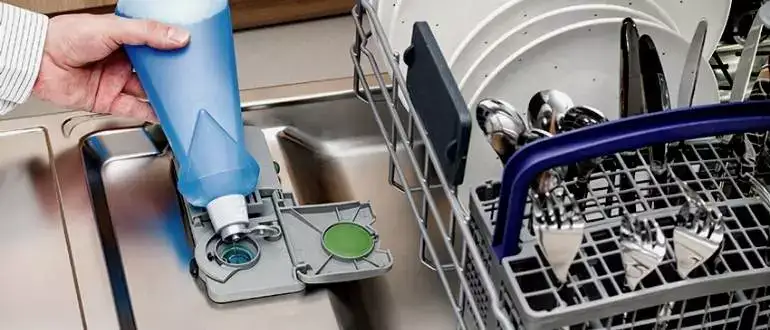
What is the rinse aid on the dishwasher?
Rinse aid is a type of product you can add to your dishwasher that will help keep the dishes clean.
Typically, it comes in three different forms: powder, gel, and liquid. All three types of products will go into the tray that holds the dishes.
It usually comes with a special dispenser on the bottom right-hand side of your dishwasher so you can easily dispense it.
Types of rinse aids for dishwashers
Rinse aid comes in powder, gel and liquid form. When you pour a certain amount of powder or a specific number of drops into your dispenser, the rinse aid will mix with the water inside your dishwasher and help clean off any food particles on your dishes.
A majority of manufacturers have formulated their detergents to clean dishes on their own, but it is still a good idea to add rinse aid so you don’t have to pre-rinse or hand wash your dishes before putting them in the dishwasher.
This product isn’t necessary, as many dishwashers already come with specialized cleaning agents that do the same job as a rinse aid.
It might also be good to try out how your dishes are coming out of the dishwasher without it, or with just a little bit, before you go ahead and invest in this product.
If you find that there is still some residue on your dishes after using the detergent that comes with your dishwasher, adding rinse aid might be a good idea.
How to use rinse aid correctly? Step By Step
1. Measure out the amount of rinse aid you need by reading the specific instructions on each product;
2. Punch a hole in the bottom of your dishwasher’s dispenser;
3. Pour in your selected type of rinse aid into the slot or cup opening within the dispenser;
4. Run an empty cycle with hot water. After it finishes, make sure to fill the dispenser with water again before running a full cycle.
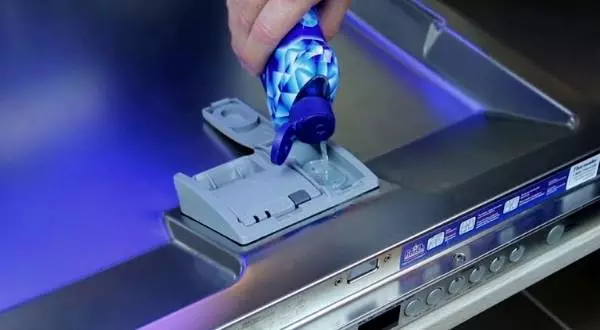
Why do I need a rinse aid?
The role of a product such as a rinse aid is to improve the overall washing performance.
Rinse aid is made up of surfactants, which are chemicals that help reduce surface tension in liquids and remove dirt from dishes.
This means that they allow water to penetrate further into items like cutlery and crockery, removing food particles stuck on them.
The surfactants in a rinse aid also help loosen grease and grime making them easier to wash away.
It can be more effective than dishwashing detergent at getting rid of dried-on food particles, particularly if you have hard water.
The importance of using a good quality rinse aids
Using good-quality rinse aid will reduce the number of water spots left on your dishes at the end of your dishwashing process.
With traditional dishwashing detergents, you need to pre-rinse your dishes before placing them in the dishwasher to remove all food residues.
However, this is not necessary with an effective rinse aid since it will reduce the amount of food residues on your dishes, to begin with.
With a good rinse aid, the detergents in the dishwashing products will activate better with water and lift off more grime from your dishes.
This means that you can wash your dishes without having to pre-rinse them!
The best way to know if there is a good amount of rinse aid left in your dispenser is to take a look at the dishes after they have been washed.
They should be completely clean and free from any white or black spots.
Some other things to consider: When using concentrated rinse aids, you will need to add a certain number of drops or dissolve a specific amount of the powder in water before adding it to your dishwasher.
If you have sensitive skin, rinse aid might irritate it, so wear protective gloves when handling this product.
Rinse aid can also be used as a fabric softener and for weed control!
Advantages and disadvantages of using a rinse aid
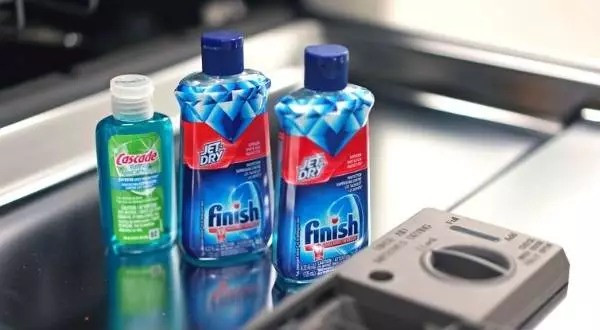
Here are ten advantages of using a rinse aid:
1. It can help prevent dishwasher film and water spots
2. It will save you time since you don’t have to pre-rinse your dishes before they go into the dishwasher
3. You will end up with a shinier, more sparkly finish on your dishes
4. Rinsing aid will help to remove even the most stubborn of kitchen grease from your dishes
5. It can fill in for a dishwasher’s missing ingredients, such as a booster or a descaling agent
6. Some rinse aids can also be used as fabric softeners and weed killers! Some brands actually sell weed killers that can be used for this purpose
7. Rinse aid is considered environmentally friendly since it reduces the amount of water and energy needed when washing dishes in your dishwasher
8. It’s super easy to use! All you have to do is add a certain amount of rinse aid according to its instructions or dissolve it in water, then pour it into your dishwasher’s dispenser
9. It reduces the number of suds generated by your dishwashing detergent
10. Using rinse aid will also help dry hard-to-reach areas on dishes, so you don’t have to run your plates under the faucet with water after you wash them.
Here are five disadvantages of using a rinse aid:
1. It can be very irritating to the skin and eyes, so make sure you use gloves when handling it
2. It can leave stains on your dishes if you don’t use enough water when adding it to the dishwasher
3. It can break down the effectiveness of your dishwashing detergent, causing it not to work as well. This is why you should never add rinse aid directly into your dishwashing detergent container
4. Not all rinse aids are environmentally friendly; make sure yours has low polluting properties before using it
5. Using too much rinse aid can cause your dishes to have a white or grey chalky residue on them, which isn’t very appetizing
How can you tell if your rinse aid has run out?
The best way to tell if your rinse aid has run out is to take a look at the dishes after they have been washed.
Do they have any water spots or film on them? If so, then you should add some more rinse aid into the dispenser of your dishwasher.
If you notice that your dishes don’t seem as shiny or sparkly as they usually are after using the dishwasher, then it might be time to replace your rinse aid.
There are many ways that you can keep track of how much rinse aid is left in your dispenser; here are some examples:
1. Use a marker or sticker and write down how much rinse aid was added to your dishwasher with each use.
2. Use a measuring cup to add the right amount of rinse aid every time you want to add some to your dishwasher.
3. You can also place an old baby food container or spice container in the top rack of the dishwasher and mark where it reaches when closed, then use the same container every time you add rinse aid to your dishwasher.
You can also buy a special measuring device that attaches to your faucet in the kitchen and tells you when it’s time to replace your rinse aid.
How do you know which types of rinse aids are safe for your dishes?
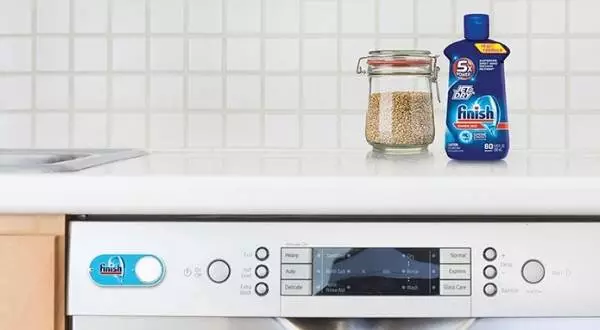
There are many different types of rinse aids available on the market so it can be difficult to determine which ones are safe for your dishes. Some of these types include:
- Water softening agents
- Wetting agents
- Drying additives
You should avoid using any type of rinse aid that contains phosphates since those can cause environmental damage.
Is there any other way to get dishes clean without using a rinsing agent?
Yes, you can use a dishwasher without using a rinse aid! You can improve your dishwashing detergent by adding some baking soda and vinegar to the base of your dishwasher once it is empty.
Let it sit for about 30 minutes, then run a load through (you don’t need to add any dishes).
To get hard-to-reach areas of your dishes sparkling clean, you can also add some vinegar to the bottom of the dishwasher while it’s empty.
What should you do if your skin or eyes get exposed to rinse aid?
If your skin comes in contact with a rinse agent, make sure you wash it off quickly. Rinse aid can be very irritating to your eyes, so make sure you rinse them out with water if any is spilled on them.
If you think there is a possibility that your skin or eyes have come in contact with a rinse aid, then it’s important to go see a doctor as soon as possible.
How can you tell if the rinse aid dispenser needs to be replaced?
There are three ways that you can tell if your rinse aid dispenser needs to be replaced; these include:
- If the rinse aid is not evenly distributed in your dishwasher
- If there is a white, chalky residue on your dishes
- If your dishes aren’t as clean and sparkly as they usually are
If you notice any of these things, then it might be time to replace your rinse aid dispenser.
What happens if you use too much rinse aid in your dishwasher?
Using too much rinse aid can cause a white residue to appear on your dishes, which is unappetizing and isn’t safe to eat.
It can also cause too much foam in your dishwasher, which means that the water temperature will be lowered.

Finally, it can cause some of your dishes to have a white or grey chalky residue on them, which isn’t very appetizing.
Can you add some baking soda to increase the cleaning power in your dishwasher?
You should avoid using any type of rinse aid that contains phosphates since those can cause environmental damage.
If you add baking soda to your dishwasher then it will increase the cleaning power of your detergent and this means that it will be able to remove any food particles from your dishes.
It may also work to improve the water pressure in the dishwasher.
This is an important thing since if the water pressure isn’t good enough then it will take a long time so that the water can penetrate into all parts of your dishes.
You can increase the cleaning power in your detergent by adding some baking soda to it once you have emptied your dishwasher.
Let it sit for about 30 minutes, then run a load through (you don’t need to add any dishes).
Another way of doing this job is by adding a cup of baking soda to the bottom of your dishwasher while it’s empty.
If you don’t have any rinse aid, you can use vinegar instead for this purpose?
Vinegar can be used instead of rinse aid for this purpose. It will leave your dishes looking clean and sparkling.
However, if you use vinegar to do this job then it is important that your dish detergent contains some phosphates so that it can remove food particles from the dishes.
Without any phosphates in your dish detergent, food particles will be left on the dishes and this increases the chance of them being eaten when they are served to eat.
Since vinegar does not contain any detergents, it cannot remove any traces of food particles from your dishes.
What should you do if someone uses a product with a high concentrate of rinse aid in their dishwasher?
If you think there is a possibility that someone has used a product with a high concentrate of rinse aid in their dishwasher, then you should tell them to carefully read the ingredient label.
If they have ingested a high concentration of this product then it can be an irritant to their skin and once swallowed it can cause nausea or vomiting.
Why does my dishwasher use so much rinse aid?
If your dishwasher uses too much rinse aid, then you might need to check the following:
It might be because of the low water pressure in your household. Check your hoses for leaks and increase the pressure if needed.
If the problem persists, then it might be due to clogged filters or screens that are meant to protect parts of your dishwasher.
If you have a water softener, then this is another reason why your rinse aid will be used up faster than usual. Is your dishwasher using too much of it? This can happen if you use more detergent or salt in your dishwasher.
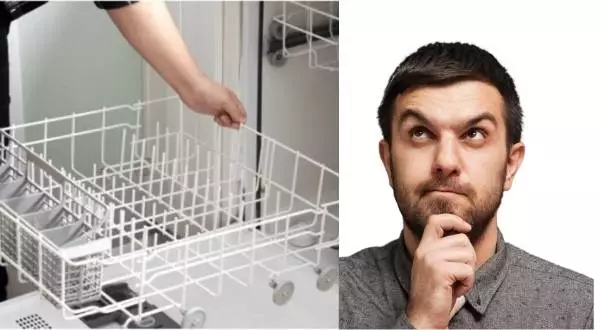
You might need to reduce the amount next time you run the machine and see if the rinse aid decreases.
Are there any alternatives to using a dishwasher rinse aid? You can substitute vinegar for the purpose of removing spots and making your dishes sparkle.
Just make sure that you don’t mix it with other cleaning products, since this will tend to create chlorine gas (which isn’t very healthy).
Also, try replacing the regular salt with the rinse aid type of salt if you have hard water.
This way, your dishes will come out cleaner and you won’t need to use as much rinse aid in order to get them sparkling again.
What can I use instead of rinse aid?
If you don’t have any rinse aid, then you can use vinegar instead. This is safe to use on all your dishes and glasses.
If you are using a phosphate-free dishwasher detergent, then it will help you in removing food particles from the dishes after they have been washed.
You can also add some baking soda to increase the cleaning power in your dishwasher.
What is the difference between dishwasher detergent and rinse aid?
Dishwasher detergent (also known as dishwashing powder) can be added directly to your dishwasher, whereas rinse aid must be measured out into a special compartment in the machine called the dispenser cup.
Most modern machines have an indicator light so that you know when to refill it with more rinse aid.
Frequently asked questions about dishwasher rinse aids
Do I Really Need Rinse Aid?
Its use is not mandatory, but it does make your dishes sparkle. Simply put, if you want your dishwasher to work at its optimum level, then a rinse aid is necessary.
What Are The Ingredients In Dishwasher Rinse Aids?
Rinse aids are composed of these chemicals: Alcohols Ethylene glycol Diethylene glycol Isopropyl alcohol Propylene glycol Monobutyl ethers of ethylene glycol
Why Is Rinse Aid Essential In Dishwashers?
Rinse aids help loosen and remove soil from dishes.
They work together with your detergent to make sure that every last speck of food residue is cleansed from your items before they are sent through the dry cycle.
What Ingredients Help Rinse Aid Work Better?
You can make sure that your rinse aid works well by making sure your dish detergent has phosphates in it since this will mean the food particles are removed during the wash cycle rather than sitting on your dishes and being dried off later as a chalky mess. You can also make sure that your dishwasher has decent water pressure.
What Is The Purpose Of Rinse Aid?
The main purpose of rinse aid is to reduce spotting and filming on dishes when they are being dried in a dishwasher.
This effect can also help in reducing water spots, too. Also, it will leave your dishes looking clean and sparkling with a nice shine, which makes them look appetizing.
Can You Use As Much As Rinse Aid As You Want?
It is recommended that you don’t use more than the maximum fill line for your dishwasher.
This can cause some problems since too much of this product can clog up some parts of your dishwasher and lead to a decrease in the performance of this machine.
How Often Should I Put Rinse Aid In My Dishwasher?
The manufacturers of some dishwashers recommend that you put it in as soon as every month or as little as once a year.
You can check your dishwasher manual to figure out what the recommended interval is for putting rinse aid into your machine.
Final Words
A dishwasher rinse aid is a product that helps with cleaning and protecting your dishes.
What does it do? It removes the food particles left on the dishes by dishwashing solution, soap or detergent.
When you use dishwasher rinse aid in conjunction with phosphate-free detergents, you can also reduce phosphates in wastewater discharge.
This means fewer algae growth! All of these benefits are why we recommend using this important addition to your dishwashing routine every time you run the dishwasher.
